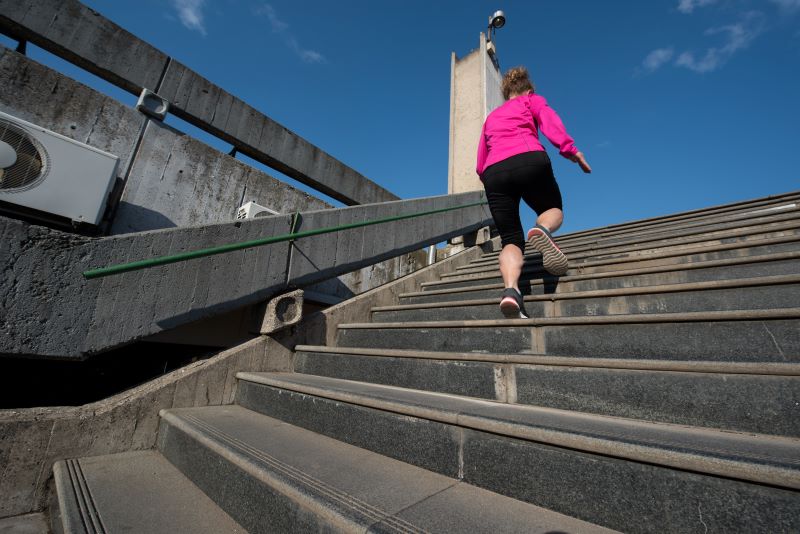20 Best Exercises for Heart Patients & Their Amazing Benefits
The heart is often considered a significant organ for sustaining a healthy lifestyle. It is naturally challenging to live with heart diseases since they are severe. Being physically active can, therefore, be a mandatory requirement for heart patients. There can be different kinds of exercises for heart patients. These depend on the severity of the diseases and the patient's specific requirements.
Are you a heart patient or caring for one? This article will give you a wholesome idea of the right exercises for heart patients!

Table of Contents

What is the Main Function of the Heart In Our Body?
The main function of the heart in our body is to pump oxygenated blood through the circulatory system and provide oxygen and nutrients to the tissues and organs. It beats without any rest at a rate of around 60 to 100 times per minute, thus enabling circulation.
Moreover, the heart helps to remove waste, including carbon dioxide, from the human body. Consequently, it is crucial to our well-being and maintaining good health.
Causes of Heart Diseases
Heart diseases can result from different factors, such as lifestyle choices, genetics, or other underlying health conditions. Understanding these can help prevent or manage them.
Sedentary lifestyle and lack of physical activity.
High levels of saturated fats, cholesterol and sodium characterise an unhealthy diet.
Smoking And Tobacco Use.
High blood pressure (Hypertension).
High cholesterol levels.
Diabetes and insulin resistance
20 Best Exercises for Heart Patients
Heart diseases are generally severe and can cause serious decay in the human body. Exercise for heart patients is essential since it can maintain healthy heart muscles. Medical practitioners also feel it can help heart patients live longer without facing chest pain issues.
Thus, no more worries about a healthy lifestyle if you are a heart patient. The following list discusses some of the most effective exercises for cardiac patients. Regular exercising will help you shed all the negative aspects of your disease and embrace a longer and healthier life.
Aerobic Exercises for Heart Patients
Heart patients are often recommended to conduct aerobic exercise. Doctors suggest brisk walking, swimming, running, cycling, jumping rope and playing tennis. It can improve blood circulation, which helps lower blood pressure and heart rate.
1. Walking and Jogging

It is one of the most common exercises for heart patients with stents. Doctors start by recommending regular walks, which are free and straightforward. Initially, heart patients should consider a smaller period and slowly extend it. It is the primary way of maintaining physical activity while developing some exercise.
On the other hand, jogging or running does not come immediately after a heart attack. However, after a significant period, your physician might prescribe regular running. Again, it would help if you started slowly and aimed for 30 miles a week. Both walking and jogging are effective ways of boosting stamina and relieving heat stress.
2. Swimming

Do you worry if you will be able to swim following a heart attack? Worry no more, as doctors recommend swimming as an ideal aerobic exercise for heart patients. It effectively increases the overall fitness level of the human body and increases energy. It can be used as an alternative to walking when the climate is unsuitable.
3. Cycling

Both outdoor cycling and indoor bike cycling can be practical exercises for heart patients. Healthcare practitioners have noted that cycling helps reduce the risks of heart disease. Your heart rate boosts with the use of the large muscles of your legs. Ensure that the weather is suitable, and keep the pedalling speed moderate while cycling.
4. Dancing

If you feel bored with all the tedious and monotonous forms of exercise, you can opt for dancing. It has been a popular cardio exercise for heart patients in recent times. You consider swing dancing, two-stepping or just the twist. It will not only increase your heart's stamina but also lighten up your mood.
5. Gardening and Yard Work

If you are not a gym freak, there is no reason to worry about your exercise form. You can visit your yard and get some aerobic workouts done in the form of gardening. Simple activities like gardening, mowing the yard, and trimming the hedges can help bring back the healthier state of your heart.
6. Jumping Rope

Jumping rope is a dynamic aerobic exercise that involves continuous jumping over a rope. It improves cardiovascular health, coordination, and agility while burning calories efficiently. Incorporating jumping rope into your routine can boost heart health and overall fitness.
7. Playing Tennis

Tennis is a versatile aerobic activity that engages the entire body, promoting cardiovascular endurance and muscle strength. It enhances agility, coordination, and reflexes while providing a fun and social way to exercise. Whether played singles or doubles, tennis offers a challenging workout suitable for heart patients aiming to improve their fitness levels.
Resistance Training Exercises for Heart Patients
This can be considered as another best exercise for heart patients. For this, you can work out with weight machines or free weights, such as hand weights, dumbbells or barbells.
You can also try body-resistance exercises, including push-ups, squats, and chin-ups. If you are a heart patient, this exercise will help you reduce weight and fat and maintain a clean muscle mass.
8. Weight Training

The key to a healthy heart includes the reduction of excess fat and reshaping muscle mass. For this, you can follow weight training as an effective exercise for heart disease patients. While this might sound tedious, weight training is not just about gym weights. Instead, your body weight can also be effective. Simple exercises such as push-ups, squats, or pull-ups can contribute to a healthy heart.
9. Body-Weight Exercises

Body-weight exercises are strength-training movements that use the body's weight as resistance. These include push-ups, squats, and lunges, which help build muscle strength and endurance without needing equipment. Incorporating body-weight exercises into your routine can improve overall strength and mobility, making them ideal for heart patients seeking to enhance their fitness safely.
10. Dumbbell Exercises

Dumbbell exercises involve using handheld weights to perform resistance-training movements targeting specific muscle groups. They offer versatility and scalability, allowing heart patients to adjust their weight according to their fitness level and goals. Dumbbell exercises promote muscle growth, strength, and stability, making them effective for improving overall physical function and cardiac health.
11. Resistance Bands

Resistance bands are elastic bands used to provide resistance during strength-training exercises. They offer a safe and effective way to build strength, improve muscle tone, and enhance flexibility without putting excessive strain on the joints. Resistance bands are portable and versatile, making them suitable for heart patients seeking resistance training at home or on the go.
Stretching and Flexibility Exercises for Heart Patients
When discussing exercise for heart patients, stretching and flexibility can be crucial. Doctors usually suggest essential stretching at home. You can also find suitable YouTube videos to use when practicing stretching. It would help if you did this every day before you started exercising. The primary purpose is to avoid joint pains and free the muscles from cramping.
12. Yoga

Doctors often prescribe yoga as a gentle exercise for heart patients, especially after an immediate heart attack. While you still move your body in yoga, the focus is on making the muscles more extended and flexible. Moreover, it is also a mental exercise, as you allow your mind to rest and wind down, lowering your blood pressure.
You can practise yoga for 30 minutes, about five days a week.
13. Tai Chi

A Chinese form of exercise based on martial arts, Tai-chi is a popular exercise for heart patients at home. Heart patients experience slow rhythmic body movements with concentration and deep breathing. The routine can be a peaceful exercise for both mind and body.
14. Pilates

Pilates is a form of low-impact exercise that focuses on strengthening muscles while improving postural alignment and flexibility. It emphasises core strength, stability, and controlled movements, making it suitable for heart patients seeking to enhance overall fitness and mobility.
15. Static Stretching

Static stretching involves holding a stretch position for a prolonged period to improve flexibility and range of motion. It helps lengthen muscles, reduce muscle tension, and enhance circulation, making it beneficial for heart patients aiming to maintain or improve their mobility.
Incorporating static stretching into a regular exercise routine can help prevent injuries, alleviate muscle soreness, and promote overall physical well-being.
16. Foam Rolling
Foam rolling, also known as self-myofascial release, involves using a foam roller to apply pressure to muscles and soft tissues to relieve muscle tightness and improve flexibility. It helps break up muscle adhesions and knots, reduce inflammation, and enhance blood flow, facilitating recovery and promoting muscle relaxation.
Cardiovascular Exercises for Heart Patients
17. Rowing

One of the typical low-impact exercises for heart patients includes rowing. You will find a rowing machine in your gym, and using it will help boost your heart rate while keeping your ticker in shape. Instead of focusing entirely on rowing, you can mix it up with 15 minutes of rowing and 15 minutes of treadmill walking.
18. Climbing Stairs

Doctors also prescribe this simple home exercise for heart patients. With time, you should aim at reaching between 50% and 85% of your maximum heart rate with climbing stairs. You can do it at home or in the gym with a stair machine. Again, this is an essential aerobic exercise for maximising stamina and strengthening your heart muscles.
19. High-Intensity Interval Training (HIIT)

This kind of exercise includes a range of short bursts of high-intensity activity with more extended periods of active recovery. It aims at full-size workouts in a shorter period and with less effort. For instance, you can run for about a minute, walk for three minutes, and continue the cycle. It raises and lowers your heart rate, which helps burn calories.
20. Circuit Training

Circuit training involves performing a series of exercises in rapid succession, typically targeting different muscle groups with minimal rest in between. It combines strength training and cardiovascular exercise, providing a comprehensive full-body workout.
Circuit training is efficient for heart patients as it improves cardiovascular fitness, enhances muscular strength, and promotes calorie burning quickly.
Types of Equipment Required for Heart Exercise
Certain heart patient exercises require specific equipment to enhance their effectiveness and safety. This table lists such exercises, ensuring that heart patients are well-prepared for a comprehensive workout routine.
Exercise |
Required Equipment |
| Jumping Rope | Jump Rope |
| Swimming | Swimming Pool or Body of Water |
| Cycling | Bicycle or Stationary Bike |
| Gardening and Yard Work | Gardening Tools (e.g., Shovel, Rake, Pruners) |
| Rowing | Rowing Machine or Equipment |
| Climbing Stairs | Stairs or Stair Climber Machine |
| Circuit Training | Various (e.g., Dumbbells, Resistance Bands, etc.) |
| Yoga | Yoga Mat |
| Resistance Bands | Resistance Bands |
| Playing Tennis | Tennis Racket |
| Foam Rolling | Foam Roller |
Benefits of Exercise for Heart Patients
Regular exercise offers numerous benefits for heart patients, improving cardiovascular health and overall well-being. Physical activity can enhance heart function, reduce the risk of complications, and promote a better quality of life.
1. Improved Cardiovascular Health
Regular exercise strengthens the heart muscle, improves blood circulation, and enhances heart efficiency, reducing the risk of heart disease and related complications.
2. Lowered Blood Pressure
Physical activity helps regulate blood pressure levels, decreasing the strain on the heart and arteries and reducing the risk of hypertension and stroke.
3. Enhanced Stamina and Endurance
Engaging in aerobic exercises such as walking, swimming, and cycling increases endurance, allowing heart patients to perform daily activities with less fatigue and exertion.
4. Weight Management
Exercise aids in weight loss and maintenance by burning calories and improving metabolic function, reducing the risk of obesity and associated cardiovascular conditions.
5. Improved Cholesterol Levels
Regular physical activity helps raise HDL (good) cholesterol levels and lower LDL (bad) cholesterol levels, promoting better lipid profiles and reducing the risk of atherosclerosis and coronary artery disease.
6. Stress Reduction
Exercise releases endorphins, neurotransmitters that promote feelings of well-being and reduce stress and anxiety. These enhance mental health and the overall quality of life for heart patients.
How Effective are these Exercises for Heart Patients?
Most medical practitioners believe that exercising is mandatory for heart patients to avoid future health complications. Apart from medications, physical activities help heart patients strengthen their heart muscles and manage their blood pressure and sugar levels. Moreover, exercising helps you lose weight, control your blood sugar, and strengthen your bones.
If you recently had a heart attack and face chronic chest pain and shortness of breath issues, different types of exercises for heart disease patients will be ideal for you. Exercise will strengthen your body, boost your stamina, and help you feel better mentally by reducing your body fat and improving your health conditions. Your heart pumps more blood without any restraint when you exercise regularly.
Who Should Avoid These Exercises?
If you are a heart patient, you must realise both the positive and negative aspects of exercising. For instance, you must ensure that your doctor recommends the types of exercises and the time for doing the same. Over-exercising can harm your health. Moreover, if you have asthma issues, you should avoid heavy exercise. People with injuries should also refrain from exercising.
- Individuals with Uncontrolled Heart Conditions: Patients who have unstable angina pectoris, uncontrolled hypertension, or recent myocardial infarction should refrain from engaging in vigorous exercise until their medical condition stabilises under the supervision of a healthcare professional.
- Those with Severe Heart Failure: Individuals with severe heart failure, characterised by symptoms such as significant shortness of breath at rest or with minimal exertion, should refrain from strenuous physical activity.
- Patients with Acute Illness or Infection: Persons who are suffering from acute illnesses such as fever, flu, or respiratory infections should not exercise until they are fully convalescent so that they don’t worsen their disease condition or get complications any further.
- Individuals with Orthopaedic Injuries: Those with musculoskeletal injuries, such as fractures, sprains, or joint pain, should avoid exercises that exacerbate their condition or cause further injury.
- Patients with Uncontrolled Asthma: Individuals with poorly controlled asthma should avoid activities that trigger respiratory symptoms, such as heavy exercise in cold or polluted environments. Exercise-induced bronchoconstriction can worsen asthma symptoms and increase the risk of respiratory diseases.
Disclaimer: Practise the exercises mentioned above under the supervision of a trained practitioner or a doctor to ensure optimal results and safety.
Therefore, people recovering from heart disease should consider exercises for heart patients. These help them recover quickly without relying entirely on medication. Moreover, they can help enhance physical and mental health and avoid future threats from heart diseases.













